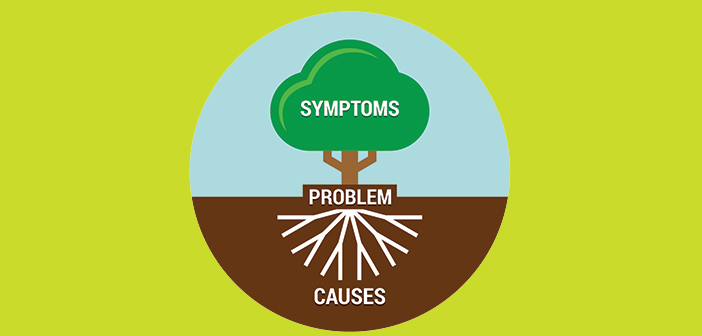Accidents happen—from high-profile disasters that get reported in the media to minor day-to-day incidents. Simply assuming that these injuries were the result of staff making a mistake, communication misfires, or not following procedures doesn’t help solve the issue. A careful root cause analysis can identify the source(s) of these incidents and help point the way to eliminating or avoiding them in the future.
What is a Root Cause Analysis?
Beneath every problem lies a cause, or causes, for that problem. Root causes are specific underlying causes that can reasonably be identified. Identifying them distinguishes the causes of the problem from just the symptoms.
Therefore, the goal of the root cause analysis is to find out how and why a problem happened, and then come up with a plan to eliminate or avoid the root causes. This works in much the same way a medical doctor examines a patient for symptoms, knowing there is an underlying illness that needs to be treated. A root cause analysis is looking for the deeper reasons for what happened. That is, the actual cause of a problem.
Determining the Cause of the Problem
Causal factors are typically the human errors and/or equipment failures that at least contribute to a problem occurring. For example, a worn-out belay device, or guide fatigue from lack of sleep and a long day working, could be causal factors. Most of the time, if the causal factors were not present, the incident could have been prevented, or would have substantially reduced the consequences of the incident.
Root causes often stem from the absence, deficiency, or neglect of the management systems that control human actions and equipment performance. In a root cause analysis, the goal is to reach that higher-level cause or the chain of cause-and-effect relationships that lead to the underlying problem.
The Process
There are several ways to conduct a root cause analysis. The first step will always be to define or clarify the problem (step 1). The five-step process here is adapted from the work of James Rooney and Lee Vanden Heuvel in 2004:
Step 1: Define or clarify the problem.Start by asking: What? When? And where? What went wrong? When did it happen? Where did it happen? It might be helpful to create a chronological description working backward.
Step 2: Collect data. Interview the people involved in the incident, using open-ended questions. Confirm facts with people. Visit the site of the incident. Conduct a literature review of similar incidents. Interview experts who can provide information to help determine the cause or causes of the incident.
Step 3: Chart the causal factors. Using a sequential diagram, organize and analyze the data collected during step two. Identify gaps and deficiencies in knowledge.
Step 4: Identify the root cause. Peel the layers of the issue until you find system failure or deficiency by looking at procedures, policies, human capital, place, equipment, and methods in place. A strong tool is the “5 Whys,” a problem-solving technique that, by asking why over and over, helps you get to the root cause of a problem.
Be prepared to find more than one cause—it might be a chain of root causes. If you identify an employee behavior as a root cause, don’t stop there; find out the why. Ask yourself: Are the procedures that this person used accurate? Is the training sufficient for the position the person has? Has the error or mistake ever been committed by another staff member? And the list can go on and on.
Step 5: Generate recommendations and implement. Create a plan or a model for improvement. This plan should have well-defined steps and measurements to make sure that the organization is improving.
A Root Cause Analysis
Let’s explore a fictitious example to illustrate these steps.
A staff member got contaminated with bodily fluids after administering first aid to a participant without using body substance isolation (BSI). Initially, we might assume that the problem is not wearing gloves, and if the staff member wore gloves, then this could have been prevented. However, that is just the symptom of a bigger problem.
Step 1: What happened? The staff member got contaminated with bodily fluids from the participant injury while administering first aid. When did it happen? At 9:33 a.m., during the walk to the next zip line. Where did it happen? Just before the second platform.
Step 2: We collect data by interviewing other participants in the group and other staff members involved. The guide or instructor at the scene wrote the incident report, and it is a good starting point to get information about the people involved and the witnesses of the incident, as well as facts that can be corroborated. In this scenario, we interviewed the staff and participant involved, plus we asked other participants to confirm the information gathered.
Step 3: We create a flow chart that illustrates the sequence of how the staff member got contaminated with the participant’s body fluids while administering first aid.
Step 4: Start asking the “five whys”:
Why was the staff member not wearing gloves and other personal protection equipment? We confirmed that the medical kits contained gloves.
Why was the staff member not wearing gloves if the medical kits had them? We learned that other staff members don’t use gloves, either, and that was the reason this staffer did not to use them.
Why don’t other staff members use gloves when administering first aid? Staff members claimed it is too hot to wear gloves. Their hands sweat a lot and “it feels uncomfortable.”
Why are the gloves uncomfortable? Is it humidity, or just heat? Would powdered gloves be better? Is there a way to make it easier/more comfortable to put on/take off gloves? Why didn’t management know about this?
We determined the root cause to be the company culture of not wearing gloves while providing first aid because staffers think gloves are uncomfortable.
Step 5: Create a plan to change the company culture to address the root cause.
First, assign one person to create a plan. He or she is accountable for creating and executing the solution, and meeting measurable benchmarks.
Then, develop a plan, with an execution date and benchmarks along the way. For our example, this plan might include: defining the non-negotiables (wearing BSI), having supervisors and other senior staff model correct behavior, keeping track of whether or not BSI is used every time a first aid kit is used, and lastly,
revision or retraining of the scene size-up process in medical incidents.
The Payoff
Conducting a root cause analysis can be a lengthy process, but if the root cause of an incident is not identified and addressed, the incident could happen again. There are some traps, such as human issues or equipment failure, but move past that first layer and keep digging down until you get to the root of the problem. The outcomes and implemented recommendations found in the process are, over the long term, important and beneficial to the organization running the business.






